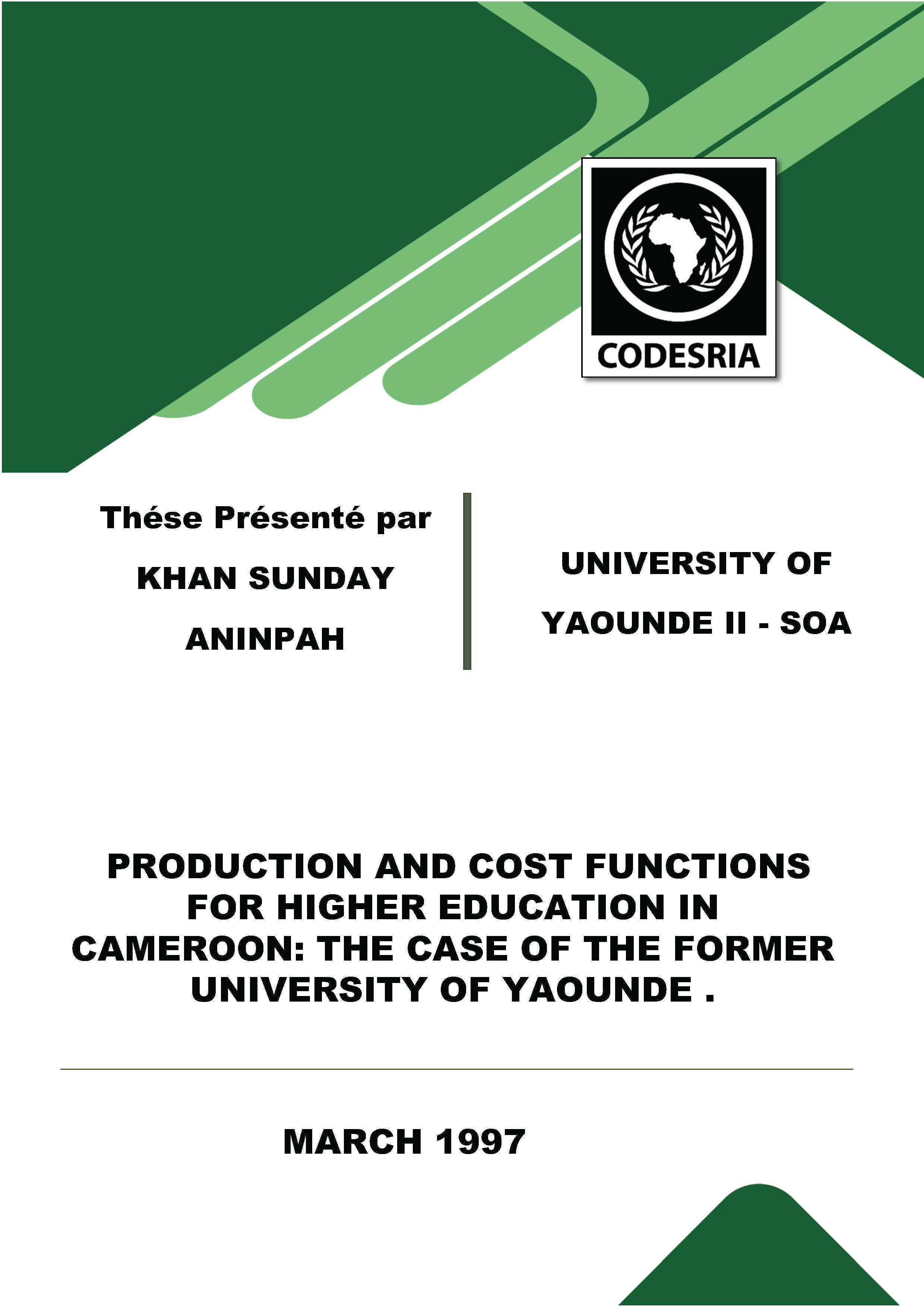Production and cost functions for higher education in Cameroon: the case of the former university of Yaounde
Keywords:
Higher education, universities, higher education institutions, educational costs, production costs, production functions, cost analysis, educational production, CameroonSynopsis
This study sets out to assess the internal efficiency of higher education in Cameroon with particular reference to the former University of Yaounde. To do this, educational production and cost functions have been estimated. They try to identify the critical inputs which impinge on the production of higher education, and to determine the relative importance· of these inputs in influencing the academic performance· of students. We also attempt to determine the impact of the inputs on expenditure per student, and the optimum size of the institution. The cointegration methodology using the ordinary least squares regression technique is applied on time series data from 1971ll2 to 1991/92. Linear and log-linear functional forms are used to estimate our relationships. Analyses are carried out first for the three faculties of the former ' University of Yaounde combined, and then, for each of the faculties separately, so as not to conceal variations within the faculties. The following results are obtained. School environmental variables explain a greater proportion of the variation in student performance. Government expenditure per student, the student-teacher ratio, the number of teaching staff, and the number of students enrolled have a significant influence on the academic achievement of students. The relative importance of the inputs is not the same in the different faculties, but the number of academic staff appear to be the most effective school input. The number of students receiving scholarships has a negative effect on performance in all the faculties, despite being the most important item in total university expenditure. Given· that expenditure per student is an aggregate of many expenditure variables, the negative relationship with · performance found in some faculties does not necessarily mean the ineffectiveness of increased government spending on higher education, but a poor allocation of expenses on the different items which comprise it - an element of efficiency. The optimum size of enrolment in the faculties was found to be 11752, 7090, 8358, and 28334 in the FDSE, FLSH, FS and all the faculties combined, respectively. These fell · below the maximum enrolments recorded by the 1991 /92 academic year (the end of our study period), which was 15554, 8781, 9171, and 33506, respectively. This implied that all the faculties were experiencing diseconomies of scale There was therefore need for restricting enrolment or decentralisation of the former University of Yaounde if efficiency was to be improved.
Downloads
References
Aguessy, Honorat. (1994). Unesco's Commitment to the Success of Higher Education in Africa. Dakar: BREDA-UNESCO..
Allen, G. R. (1974). The Graduate Students' Guide to Thesis and Dissertations: A Practical Manual for Writing and• Research. Washington D.C: Jossey-Bass Publishers.
Blaug, Mark. (1974). L'Education et le probleme d'emploi dans les Pays en voie de developpement. Geneva: BIT.
Bowen, Howard. R. (1977). Investing in Leaming: The Individual and Social Value of American Higher Education. Washington, D C: Jossey-Bass Publishers.
Bureau Regional d'Education en Afrique (BREDA). (1988). Special programmes for the Improvement of Higher Education in Africa. Dakar: BREDA•UNESCO. (1994). Orientations Futures pour l'Enseignements Superieyrs en Afrique. Dakar: BREDA-UNESCO.
Chateh, Peter N . and Jacques Negha. (1982). Apercu General sur la Bibliotheque Universitaire Bibliotheque de l'Universite de Yaounde.
Chuku, Dike. (1987). Resoyrce Allocation in EdyC§tion. Port Harcourt: Andisen Nigeria Ltd.
Cohn, Elchanan. (1979). The Economics of . Education. Cambridge: Ballinger Publishing Company.........................
Coombs, H Philips and Jacques Hallak. (1987). Cost Analysis in Education: A Tool for Policy and Planning. EDI Series in Economic development. Baltimore: The John Hopkins University Press.
Cooper, Russel M. and Margaret B. Fisher. (1975). The Vision of the Contemporary Unjversity. A case Study of Expansion and Development in American Higher Education. 1950-1975. Tampa: University Press of Florida.
Deith, Kenneth. (1969). "Some Observations on the Allocation of Resources in Higher Education". In, Readings in the Economics of Education, edited by Bowman et al. Paris: UNESCO.
Dockrell, W. B. (1990). Evaluation Procedures used to Measure the Efficiency of Higher Education Systems and Institutions: The Netherlands. Paris: UNESCO.
Eze, Agom. (1983). Economics of Education: The Nigerian Experience. Oweri: New African Publishing Co. Ltd.
Ferguson, C E. (1975). The Nao-Classical Theory of Production and Distribution. London: Cambridge University Press.
Galabawa, J. C. J. (1993). Study on the Cost-effectiveness and Efficiency in African Universities: A Case of the University of Zambia. Accra: Association of African Universities.
Goldberger, Arthur S. (1964). Econometric Theory. New York: John Wiley and Sons Inc.
Guitton, Henri. (1959). Statistigue et Econometrie. Paris: Dalloz.






